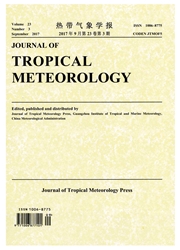

 中文摘要:
中文摘要:
在大陆中国上的 landfalling 台风 Talim (2005 ) 的降水上的地面的影响用大气的研究 Mesoscale 模型的第五产生的宾夕法尼亚州的大学公民中心被调查。模仿的台风(控制) 的模仿的降水仔细匹配观察。与控制模拟作比较,四敏感模拟在哪个 Wuyi 山, Lushan, Dabieshan,和 Lushan 的地面被执行, Dabieshan 完全分别地被移开,但是另外的表面性质被保留。Wuyi 山, Lushan 和 Dabieshan 的复杂地面在降雨紧张和 Talim 的分发上有重要影响,这被发现。当地面被移开,降雨很极大地被减少,在内陆区域的降雨在沿海的区域就多于那被减少。而且, Lushan 和 Dabieshan 附近的降雨分发与控制模拟相比更向西被散布。进一步的分析证明 Wuyi 山将增加低级空气集中和为就乍见陆地并且这样做了它的 Talim 的空气分叉将贡献的上面的水平传送对流和增加降雨紧张。Wuyi 山, Lushan 和 Dabieshan 的地面在 Talim 降雨上有明显的影响,这能被结束,并且他们的影响在学习是的在场的各种各样的 landfalling periods.The 是不同的在大陆中国在 TC 上探索山志学的影响的一次有用尝试。
 英文摘要:
英文摘要:
The impact of terrains on the precipitation of landfalling typhoon Talim (2005) over mainland China is investigated using the fifth-generation Pennsylvania State University-National Center for Atmospheric Research Mesoscale Model. The simulated precipitation of simulated typhoon (the control) matches the observations closely. To compare with the control simulation, four sensitivity simulations were carried out in which terrains of Wuyi Mountain, Lushan, Dabieshan, and both Lushan and Dabieshan are completely removed respectively, but other surface properties were retained. It is found that the complex terrains of Wuyi Mountain, Lushan and Dabieshan have a significant impact on the rainfall intensity and distribution of Talim. As the terrains are removed, the rainfall is decreased very greatly and the rainfall in inland area is decreased much more than that in the coastal area. Besides, the rainfall distribution near the Lushan and Dabieshan is spread much more westward compared with the control simulation. Further analysis shows that the Wuyi Mountain would increase both the lower level air convergence and the upper level air divergence for Talim that just made landfall and thus it would contribute to the convection and increase rainfall intensity. It can be concluded that the terrains of Wuyi Mountain, Lushan and Dabieshan have obvious impacts on the Talim rainfall, and their impacts are different in various landfalling periods. The present study is a useful attempt to explore the influence of orography on the TCs in mainland China.
 同期刊论文项目
同期刊论文项目
 同项目期刊论文
同项目期刊论文
 BOUNDARY LAYER STRUCTURE IN TYPHOON SAOMAI (2006): UNDERSTANDING THE EFFECTS OF EXCHANGE COEFFICIENT
BOUNDARY LAYER STRUCTURE IN TYPHOON SAOMAI (2006): UNDERSTANDING THE EFFECTS OF EXCHANGE COEFFICIENT 期刊信息
期刊信息
